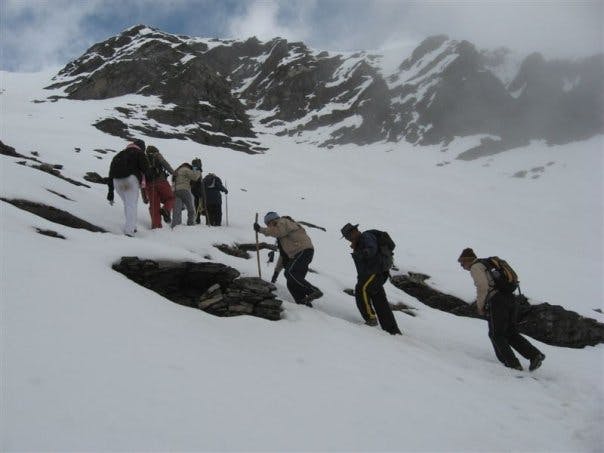How to motivate yourself for a summit climb
Share this story
“It is not the mountains we conquer, but ourselves.” The words of Edmund Hillary rings true when you confront the hunger, thirst, cold not to mention exhaustion in the mountains. You are up against yourself. And you cannot stop as you still have to go that extra mile. So how to motivate yourself for a summit climb? Planning ahead, self-motivation, steady rhythm, yoga stretches have all been recommended by a team of experts. Take a look.
The Pin Parvati Pass trek. PC – Ian Chung
Being physically fit:
The need to be physically fit cannot be stressed enough – you trek at high altitudes, the trek days are long and the climb to the summit may take hours. The Stok Kangri is one such summit. It is a high altitude trek at 20,100 feet, the air is thinner at 60% and the summit day is around 15 hours. Imran Bhaidani who scaled Stok Kangri in 2014, disciplined himself to prepare for this summit for more than a year. He says, “My weekly training included strength/weight training, swimming for 45-50 minutes, staircase training for 45 minutes, cardio and running for five kilometres in 25 minutes. I also took care to see that I had adequate rest, two days of the week.”
Tip – Know that you are going to summit, read about it, try to gain knowledge of what you may expect and work really hard to prepare for it. If you don’t work hard to achieve it you may easily give up mentally under tough conditions.
For your easy reference here is a fitness schedule to help you get in top physical shape.
Taking one step at a time:
Self-doubt can creep in when defeat is staring at your face. “Instead of self-defeating thoughts and trying to think of yourself as a failure, keep yourself small targets. The breaking down of a task in to simpler ones, makes things easier and more manageable,” says Vasantha Sanath, a trainer at a counselling academy. Parth Phalke, a trek leader at Indiahikes resonates this when he says, “Instead of dragging yourself to the top, push yourself to go a certain distance, take rest and then move forward.” Taking one step at a time also helps you take your mind off troubles and helps you focus in the present moment.
Tip –
On the way to Brahmatal top. PC – Vishwas Krishnamurthy
Maintaining a steady rhythm:
Pace your step with your breath. “Breathlessness signifies that you are going too fast. So set a steady pace by synching your steps with your breath. This steady pace will help you reach the top,” assures Manish Pasad, Chief of Operations, Indiahikes. Here he also points out the dangers of comparing yourself with other trekkers. He says, “It is just you and the mountains. So let go of other distractions and focus on yourself.”
Tip – If you are short of breath pause a bit, bend forward, take two deep breaths and move forward.
Yoga stretches:
Yoga loosens you up. Tanushree a yoga trainer says, “Deep breathing, warm stretches and Pranayama helps relax your mental tensions.” To get rid of pains and cramps she also recommends cool down stretches. To name a few – Yashtik-asana, Tadasana, Hastapadasana, Paschimota-asana etc.
Preparing mentally:
“A trek starts when you start from your home, not when you reach the base camp. Being in picnic mode does not help,” says Manish. Imran Bhaidani seconds this. He says, “As I was preparing myself for the summit for more than a year by doing intensive physical training, reading articles on high altitude effects, buying good equipment etc I was fully charged up. Once I started the summit I was totally focused on my goal to reach the top.” This focus and discipline helped him scale the summit.
Tip – On the trek before you attempt summit you get enough opportunities to understand yourself. Be disciplined in eating, drinking and taking rest. Try out the equipment and be comfortable using it before the summit attempt. On the summit day take adequate rest as well.
The Kedarkantha summit. PC – Sushil Chauhan
Parth sums it all up when he adds thoughtfully, “As a team we should be accommodative enough if a trekker is lagging behind. Listening to him, giving him positive strokes, motivating him should be done so that he does not feel the entire burden rests on his shoulders alone.”
Sign up for our much loved Weekly Mailer
We have terrific trekking tips, trek updates and trek talks to look forward to

